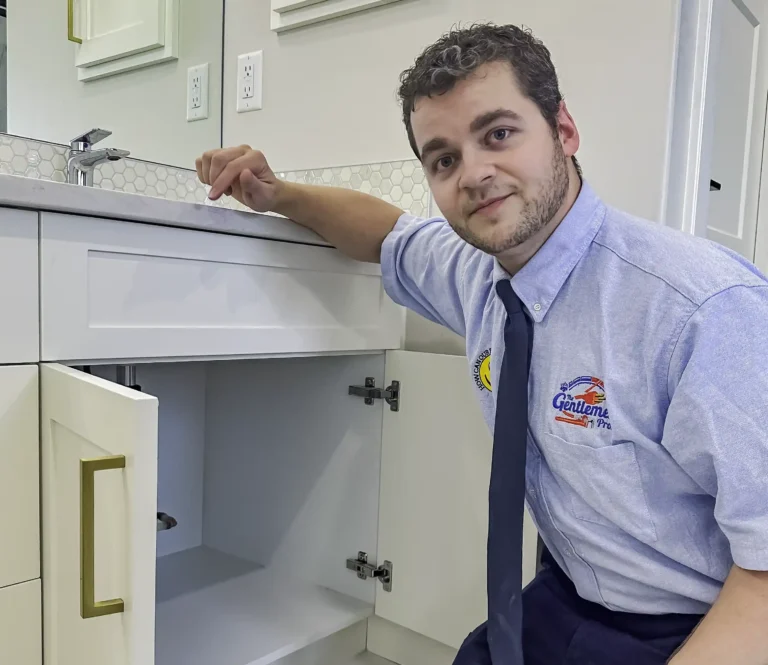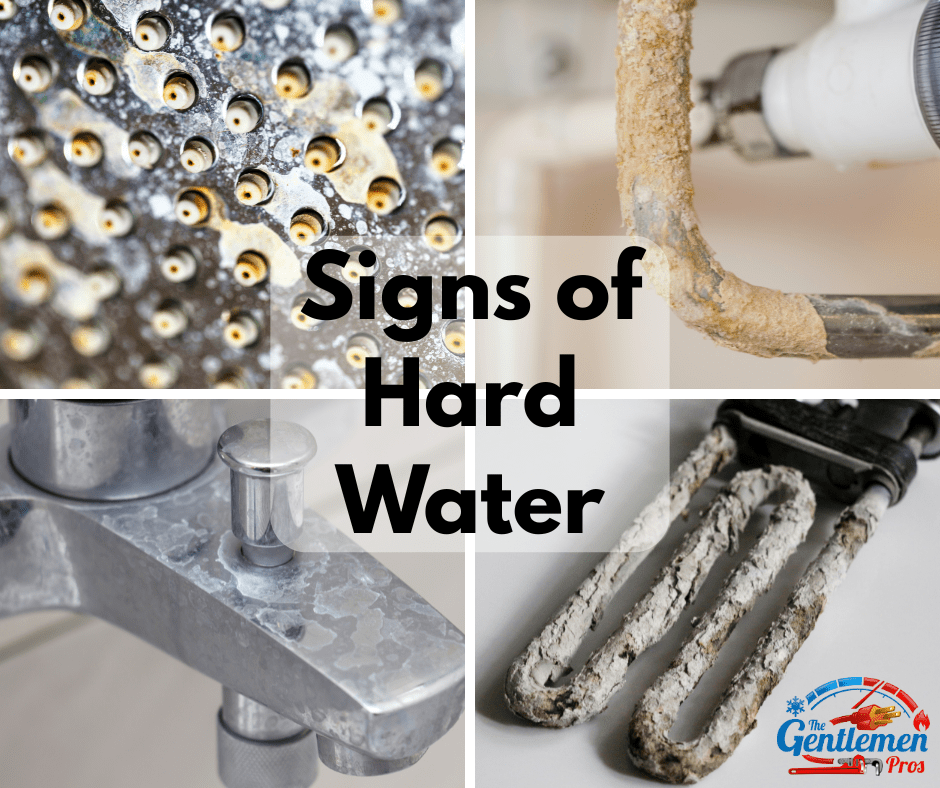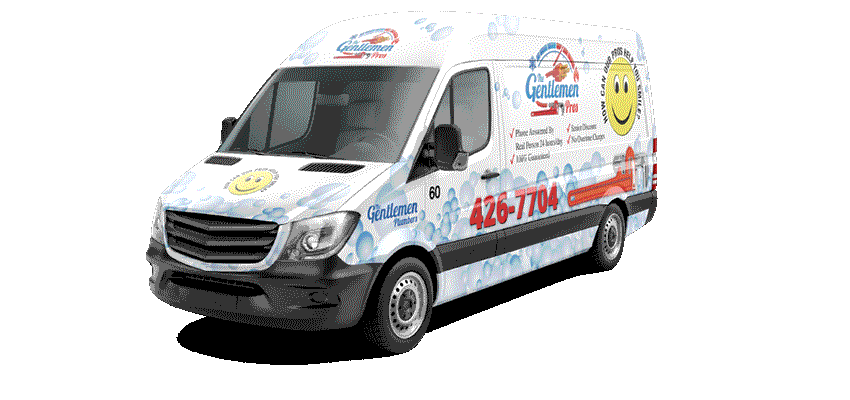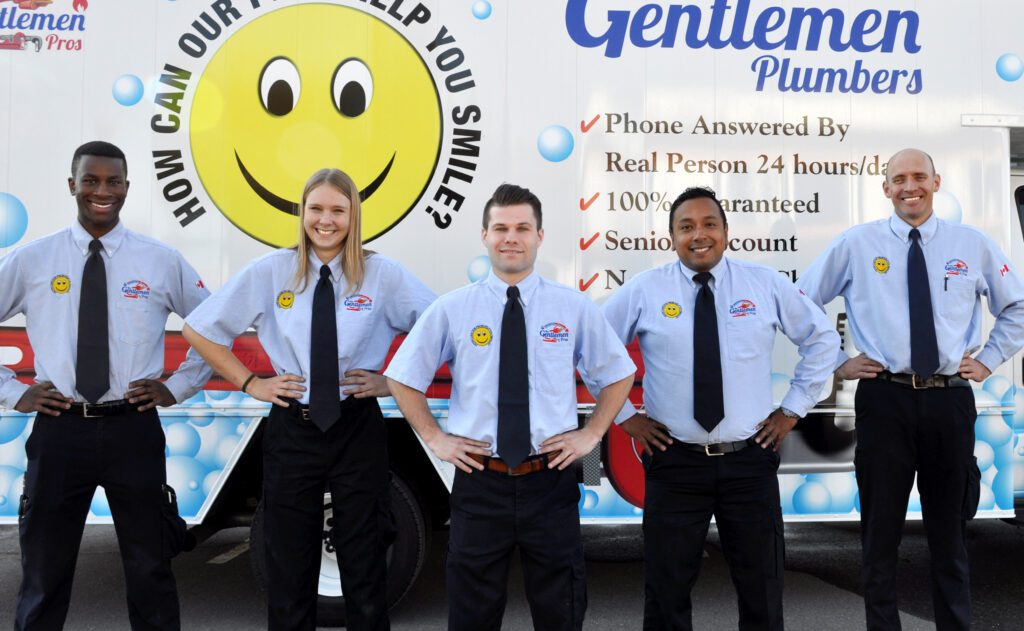
Same Day Service Since
2001
Call The Gentleman Pros Now!
(403) 879-1819
Hard water is water with high levels of dissolved minerals that can leave mineral deposits and buildup on your plumbing fixtures and appliances. Hard water can decrease the life of your water heater and plumbing fixtures, and increase the amount of buildup and soap scum in your kitchen and bathroom.
Read on to have all your questions answered about hard water and how to manage hard water in your home with or without a water softener.
Skip to how to save money, and extend the life of appliances, and plumbing fixtures in your home with hard water buildup.


Easy, you can buy a kit. (Here is a link.) But, usually that isn’t necessary.
Here are a few signs that you may have hard water:
Does this look familiar? If you have any signs of buildup, then you know you have hard water in your home.
Most jurisdictions are aware of the mineral content in the local water supply. Often, utility companies or local governments post the water hardness level.
If you live in Alberta, here is a table of the water hardness level in your area.
| City Name | Hardness (mg/L) | Hardness (Grains/Gallon) | Source |
|---|---|---|---|
| Airdrie | 165 – 216 | 11.6 – 15.1 | Source |
| Banff | 190 | 11.1 | Source |
| Bassano | 173 | 10.1 | Source |
| Bow Island | 170 | 9.9 | Source |
| Brooks | 180 | 10.5 | Source |
| Calgary | 166 – 216 | 11.6 – 15.1 | Source |
| Cardston | 230 | 13.5 | Source |
| Cochrane | 180 | 11.0 | Source |
| Coleman | 145 | 8.5 | |
| Drumheller | 296 | 17.3 | |
| Duchess | 173 | 10.1 | Source |
| Edmonton | 182 | 10.2 | Source |
| Fort Macleod | 168 | 9.8 | |
| Fort McMurray | 184 | 10.8 | Source |
| Fort Saskatchewan | 165 | 9.6 | Source |
| Grande Cache | 325 | 19 | |
| Grand Prairie | 209 | 12.2 | Source |
| Granum | 181 | 10.9 | |
| Kananaskis | |||
| Lake Newell | 173 | 10.1 | Source |
| Lancombe | 220 | 12.9 | Source |
| Leduc | 165 | 9.6 | Source |
| Lethbridge | 158 – 211 | 9.2 – 12.3 | Source |
| Linden | 263 | 15.4 | |
| Lloydminster | 181 | 10.6 | |
| Medicine Hat | 150 – 240 | 8.7 – 14 | Source |
| Michichi | 220 | 12.9 | Source |
| Okotoks | 213 | 12.5 | |
| Olds | 184 | 10.8 | |
| Patricia | 173 | 10.1 | Source |
| Pincher Creek | 156 | 9.1 | Source |
| Ponoka | 220 | 12.9 | Source |
| Rainier | 173 | 10.1 | Source |
| Raymond | 242 | 14.2 | |
| Red Deer | 220 | 12.9 | Source |
| Rolling Hills | 173 | 10.1 | |
| Rosemary | 173 | 10.1 | Source |
| Scandia | 173 | 10.1 | Source |
| Sherwood Park | 182 | 10.2 | Source |
| Spruce Grove | 172 | 10.1 | Source |
Hard water is water with a high mineral content, meaning high levels of calcium and magnesium in the ground and surface water.
Calcium and magnesium come from rocks that dissolve in our river systems, such as limestone. Typically, water is considered hard if the concentration of calcium carbonate is greater than 120 mg/l.
Alternatively, soft water contains low levels of calcium or magnesium. Municipal water that is soft is more likely to have pipe corrosion because of the water’s low pH. (Read on to understand how soft water can be problematic for your home.)
Hard water leaves behind a mineral scale, which is a chalky substance that builds up over time.
You may notice scale as you clean your bathtub, but perhaps less obvious is how it builds up in your water lines, nozzles and appliances. Over time, the scale can calcify, build up and impede water flow, or coat the inside of pipes and water tanks.
Soap scum is created when dissolved minerals bond with soap. Water softeners are desirable because they remove dissolved minerals that would otherwise cause scum when hard water comes in contact with soap.
Any appliance that uses water can be damaged by hard water. Appliances most impacted by hard water are your water heater, dishwasher and washing machine and coffee maker.
One way of managing hard water is by having a water softener installed in your home. The water runs through a deionization station, filtering the mineral out of the water.
(Read more on water softeners here, and how to manage soft water in your home.)
If installing a water softener is not an option at this time, consider scheduling routine cleaning/descaling to remove mineral build-up in your plumbing fixtures and appliances.
Here are some tips for hard water maintenance in your home.
Your dishwasher is affected by hard water when mineral scale builds up on the nozzles and drains inside the dishwasher.
Descale your dishwasher using a descaling solution.
For a descaling rinse, run your dishwasher on empty. Place a bowl of descaling solution on the top rack, and fill the soap dish with descaling solution. Run the dishwasher on the hottest setting, and much of the scale should dissipate.
As mineral caps build up on the nozzles of the water jets, they block water from spraying the dishes. Descale stubborn mineral scale on the nozzles using a brush (perhaps a toothbrush) and vinegar.
Hard water scales can build up inside the washing machine and water lines. Periodically, rinse the scale away by running an empty load with a couple of cups of vinegar on a warm setting. This will dissolve most of the hard water buildup and help dissolve soap scum buildup.
Coffee makers are notorious for building up hard water scale. To remove the buildup, flush your coffee maker with a descaling solution. Mix hot water and descaling solution at a 1:1 ratio. Flush your coffee maker every 6 months, depending on use.
Water Heaters or tankless water heaters have mineral scale buildup over time.
If you have a hot water heater (or hot water tank), sediment from the hard water will settle at the bottom of the hot water heater. Flush your water tank every year to help clear out the sediment.
The anode is an essential component of the hot water tank. It sits inside the water heater and extends through the tank interior. The anode rod’s job is to attract minerals to extend the life of the water heater. Over time, the anode will corrode and wear down. If the anode is not replaced, the interior of the hot water tank will wear out faster.
Tankless hot water heaters also need to be serviced yearly to flush out the scale that builds up inside. As scale builds up inside the tankless heater, it becomes less efficient and more costly to operate.
Cleaning your tankless hot water heater each year will extend its life and increase its efficiency. The tank needs to be flushed with a descaling solution to remove all the hard water buildup.
Hard water (water with dissolved minerals) creates soap scum when the dissolved minerals and soap bind together. Not only does this create a film on appliances, pipes, and bathroom fixtures…soap scum also binds to your skin and hair. Soap is less effective and doesn’t lather properly or clean as well when it is dissolved in hard water.
The easiest way to compensate for this is to use more detergent.
More detergent may be required depending on the hardness level of the water. Also, keep in mind that more detergent binding with minerals will make more soap scum.
Soap scum can be difficult to deal with when it builds up on plumbing fixtures, pipes and appliances. Consider using an organic drain cleaner to consume the soap scum buildup. BioOne is a bacterial cleaner that, when added to the drain, will consume organic buildup, including soap scum.
Mineral deposits often build up on showerheads as hard water flows through and dries. The residue of mineral buildup can block flow and needs to be removed from time to time, depending on the hardness of the water. Strong chemicals are not needed or recommended and can cause damage.
Also, consider cleaning the filter screen, typically found between where the shower head attaches to the pipe. Soak the filter screen in a descaling solution or gently brush it with the solution using a toothbrush. Once the filter is clean, reattach the showerhead.
Another way to mitigate hard water in your home is by using a water softener.
The water softener removes minerals as water runs through a salt solution before the water is dispersed through the rest of the home.
Water softeners are helpful because they reduce the amount of mineral buildup on appliances and plumbing fixtures, extending the life and saving money in the long run in most situations.
Beware, water softeners can create aggressive water. Aggressive water is typically slightly acidic water with a low mineral content. Wanting to replace the lost metal ions, aggressive water can degrade metal and be corrosive over periods of time.
Older homes may have metal plumbing pipes that could be impacted by a water softener in the home. (Read about sewer pipe history to learn more.) Homes built in the last 40 years will most likely have plastic plumbing pipes.
Installing a water softener will impact the speed at which your water tank corrodes.
An Anode rod is a sacrificial metal rod that controls the degradation of your water heater. Over time, the water breaks down the anode rod, preventing corrosion in your water tank.
Maintain your water heater by flushing the tank every year (whether you have soft or hard water).
We recommend an aluminum anode rod over a magnesium anode rod because it will take longer to break down.
Most often, the anode rod will need to be replaced every two years if you have softer water and every 4 years if you have hard water in your home.
There are no known side effects from drinking hard water, but using water from a water softener isn’t ideal for people on a low-sodium diet. Water softeners often use a salt deionization process to soften the water.



